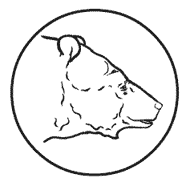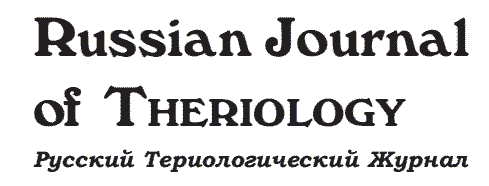Geographic distribution and ecological niche divergence of the Palaearctic petrophilous pikas (Ochotona, Lagomorpha, Mammalia) of the subgenus Pika
Lissovsky A.A., Shakula G.V., Obolenskaya E.V.
P. 114-125
The comparison of species distribution models and hyperspaces of ecological predictors was carried out in four species of petrophilous pikas of the subgenus Pika: Ochotona alpina, O. turuchanensis, O. hyperborea and O. mantchurica. All tests show significant differences between species, indicating good niche divergence. One of the species, O. hyperborea, lives in sympatry with two other species: O. alpina and O. turuchanensis; this is most likely due to different ecological preferences. The important role of geographical barriers in realising the potential distribution of these four species is demonstrated. The occurrence of O. hyperborea in China is reported for the first time.
DOI: 10.15298/rusjtheriol.23.2.02References- Brown J.L. & Carnaval A.C. 2019. A tale of two niches: methods, concepts, and evolution // Frontiers of Biogeography. Vol.11. No.4. P.e44158. DOI: 10.21425/F5FBG44158
- Brun P., Zimmermann N.E., Hari C., Pellissier L. & Karger D.N. 2022. CHELSA-BIOCLIM+ A novel set of global climate-related predictors at kilometre-resolution // EnviDat. DOI: 10.16904/envidat.332
- Elith J., Phillips S.J., Hastie T., Dudík M., Chee Y.E. & Yates C.J. 2011. A statistical explanation of MaxEnt for ecologists // Diversity and Distributions. Vol.17. No.1. P.43–57. DOI: 10.1111/j.1472-4642.2010.00725.x
- Formozov N.A. & Yakhontov E.L. 2003. Sympatry zone of alpine (Ochotona alpina) and northern (O. hyperborea) pikas on the Putorana Plateau with description of new subspecies Ochotona hyperborea naumovi ssp. n. // Zoologicheskii Zhurnal. Vol.82. No.4. P.485–496.
- Formozov N.A. 1986. Areas of sympatry of alpine and northern pikas // Proceedings of the 4th Meeting of the Vsesoyuznoe Theriologicheskoe Obshchestvo. Moscow. Vol.1. P.146–147.
- Global forest watch. 2024. World resources Institute. Available from: https://www.globalforestwatch.org. Accessed: 15 May 2024.
- Guillera-Arroita G., Lahoz-Monfort J.J., Elith J., Gordon A., Kujala H., Lentini P.E., McCarthy M.A., Tingley R. & Wintle B.A. 2015. Is my species distribution model fit for purpose? Matching data and models to applications: Matching distribution models to applications // Global Ecology and Biogeography. Vol.24. No.3. P.276–292. DOI: 10.1111/geb.12268
- Hengl T. 2019. Global river density, seasonal and surface water occurrence and upstream area at 250 m in the Goode Homolosine projection. Available from: https://zenodo.org/records/3355007. Accessed: 25 Apr 2024.
- Hutchinson G.E. 1957. Concluding remarks // Cold Spring Harbor symposium on quantitative biology “Population Studies: Animal Ecology and Demography”. Vol.22. P.415–427.
- Karger D.N., Conrad O., Böhner J., Kawohl T., Kreft H., Soria-Auza R.W., Zimmermann N.E., Linder H.P. & Kessler M. 2017. Climatologies at high resolution for the earth’s land surface areas // Scientific Data. Vol.4. No.1. P.170122. DOI: 10.1038/sdata.2017.122
- Kass J.M., Muscarella R., Galante P.J., Bohl C.L., Pinilla-Buitrago G.E., Boria R.A., Soley-Guardia M. & Anderson R.P. 2021. ENMeval 2.0: Redesigned for customizable and reproducible modeling of species’ niches and distributions // Methods in Ecology and Evolution. Vol.12. No.9. P.1602–1608. DOI: 10.1038/sdata.2017.122
- Lissovsky A.A. & Serdyuk N.V. 2004. Identification of Late Pleistocene pikas (Ochotona, Lagomorpha, Mammalia) of the alpina-hyperborea group from Denisova Cave (Altai) on the Basis of the anterior lower premolar (p3) // Paleontological Journal. Vol.38. No.6. P.680–686.
- Lissovsky A.A. 2003. Geographical variation of skull characters in pikas (Ochotona, Lagomorpha) of the alpina-hyperborea group // Acta Theriologica. Vol.48. No.1. P.11–24.
- Lissovsky A.A. 2014. Taxonomic revision of pikas Ochotona (Lagomorpha, Mammalia) at the species level // Mammalia. Vol.78. No.2. P.199–216. DOI: 10.1515/mammalia-2012-0134
- Lissovsky A.A., Dudov S.V. & Obolenskaya E.V. 2021. Species-distribution modeling: advantages and limitations of its application. 1. General approaches // Biology Bulletin Reviews. Vol.11. No.3. P.254–264. DOI: 10.1134/S2079086421030075
- Lissovsky A.A., Ivanova N.V. & Borisenko A.V. 2007. Molecular phylogenetics and taxonomy of the subgenus Pika (Ochotona, Lagomorpha) // Journal of Mammalogy. Vol.88. No.5. P.1195–1204.
- Lissovsky A.A., Yatsentyuk S.P. & Ge D. 2016. Phylogeny and taxonomic reassessment of pikas Ochotona pallasii and O. argentata (Mammalia, Lagomorpha) // Zoologica Scripta. Vol.45. No.6. P.583–594. DOI: 10.1111/zsc.12180
- Merow C., Smith M.J. & Silander J.A. 2013. A practical guide to MaxEnt for modeling species’ distributions: What it does, and why inputs and settings matter // Ecography. Vol.36. No.10. P.1058–1069. DOI: 10.1111/j.1600-0587.2013.07872.x
- Muscarella R., Galante P.J., Soley-Guardia M., Boria R.A., Kass J.M., Uriarte M. & Anderson R.P. 2014. ENMeval: An R package for conducting spatially independent evaluations and estimating optimal model complexity for Maxent ecological niche models // Methods in Ecology and Evolution. Vol.5. No.11. P.1198–1205. DOI: 10.1111/2041-210X.12261
- Ouellet Dallaire C., Lehner B., Sayre R. & Thieme M. 2019. A multidisciplinary framework to derive global river reach classifications at high spatial resolution // Environmental Research Letters. Vol.14. No.2. P.024003. DOI: 10.1088/1748-9326/aad8e9
- Warren D.L. & Seifert S.N. 2011. Ecological niche modeling in Maxent: the importance of model complexity and the performance of model selection criteria // Ecological Applications. Vol.21. No.2. P.335–342. DOI: 10.1890/10-1171.1
- Warren D.L., Glor R.E. & Turelli M. 2010. ENMTools: a toolbox for comparative studies of environmental niche models // Ecography. Vol.33. No.3. P.607–611. DOI: 10.1111/j.1600-0587.2009.06142.x
- Zhang J.-S., Li B.-Q., Yang Q.-J., Zhang Q., Wang C. & Liu Z. 2020. Sequencing and analysis of the complete mitochondrial genome of Ochotona coreana from China and its phylogenetic analysis // Mitochondrial DNA Part B. Vol.5. No.2. P.1241–1243. DOI: 10.1080/23802359.2020.1731353
Download PDF
|

